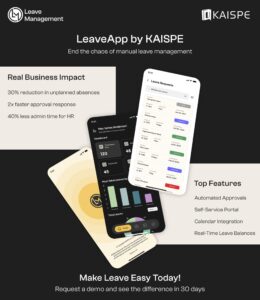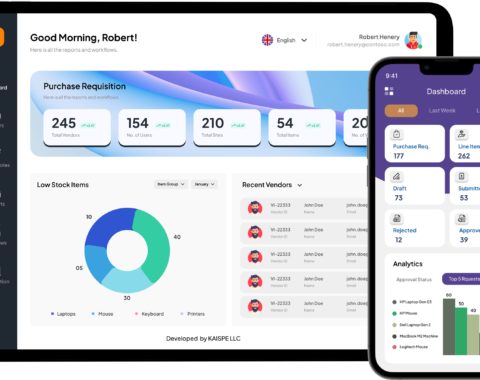Mastering employee leave management is no longer just an HR task—it’s a business necessity. Poor leave management can quietly wreak havoc on your team: unplanned absences derail project timelines, staffing gaps cause burnout, and frustrated employees lose trust in the system. HR teams drown in spreadsheets trying to track who’s off and when, while managers scramble to keep operations running. Employees, meanwhile, are left guessing—unsure if their time-off requests will be approved or when. And the ripple effects extend far beyond scheduling headaches—poor leave management costs businesses an estimated $3,600/year for each hourly worker and $2,650 annually for salaried employees through lost productivity, overtime costs, and administrative burdens.
But it doesn’t have to be this chaotic. With a streamlined system like LeaveApp by KAISPE, you can transform leave management into a smooth, automated process that boosts productivity and ensures compliance. This blog post explains employee leave management, why it matters, and how to implement it using data, best practices, and the right tools!

What is Effective Leave Management?
Employee leave management is a systematic process for evaluating, approving, and managing employee time-off requests for sick days, vacations, parental leave, and unpaid time off. The advantages of leveraging effective leave management are objective and quantifiable.
- Employers with effective leave management processes ensure fairness and compliance with complicated labor regulations, such as the Family and Medical Leave Act of 1993 (FMLA). The FMLA mandates that employers provide eligible employees with up to 12 weeks of unpaid, job-protected leave for particular family and medical reasons.
- Effective leave management processes also mitigate understaffing and employee burnout by providing clear insight into employee availability, enabling workforce planning and management.
- Leave management strategies will improve employee satisfaction and retention. Companies that develop these strategies recognize that employees who enjoy a positive leave experience experience increased motivation, productivity, and workplace loyalty.
Key Challenges in Employee Leave Management
The modern workplace faces numerous obstacles to effectively managing employee absences. Manual tracking systems remain one of the most significant pain points, with 67% of HR managers citing leave and absence management as a top challenge.
- Manual tracking Errors: Old-fashioned methods like spreadsheets lead to mistakes, such as incorrect balances, overlapping leaves, and payroll mistakes.
- Last-minute leaves: Last-minute leaves disrupt workflows, leave managers in a scramble, and frustrate team members who are doing additional work.
- Lack of Visibility: Project planning can be a nightmare without tracking who is out when, and important tasks can slip through the cracks.
- Compliance Risk: Inconsistent policy enforcement could lead to violations of FMLA or local labor laws and potentially land companies in legal trouble.
- Delayed and Slow Approvals: A slow response causes employee dissatisfaction, diminishes trust in HR, and might make team members explore alternatives.
Essential Metrics for Employee Leave Management
Understanding what the metrics for leave management are is crucial for organizations seeking to optimize their processes and make data-driven decisions.
- Absence Rate: Total leave days / Available workdays * 100. A higher number indicates overuse of leaves. This is the fundamental benchmark for unscheduled absenteeism rates, which range from 5% to 10% across industries.
- Leave Approval Time: It is the average time taken to respond to leave requests. Organizations are implementing a critical metric to reduce the approval time by up to 85%.
- Leave Denial Rate: It provides insights into policy strictness and potential fairness issues. Excessively high rates indicate overly restrictive policies, while very low rates suggest inadequate controls.
- Leave Trend Patterns: It analyzes frequent short leaves and peak seasons, particularly summer holidays, that help in resource planning.
Best Practices for Optimizing Leave Management
Clear Leave Policies
Define your leave policies, including leave type, eligibility, accrual methods, and application procedures. Specify how far in advance requests must be made and how overlapping or peak-season leave will be managed.
Automate with Leave Management Software
The manual process of manually leaving through emails and spreadsheets is inefficient. Therefore, automating the HR process with LeaveApp by KAISPE is better. It streamlines leave management, improves accuracy, and reduces admin workload.
Top Features to Look For
When choosing a digital solution for employee leave management, it is essential to look for features that simplify both the employee and HR experience.
- It has a self-service employee portal, which allows staff to view their leave balances, submit requests, and track approvals without relying on HR teams, minimizing delays and confusion.
- The platform’s real-time leave balance tracking ensures that data is always up-to-date, preventing accidental overuse or miscalculations.
- With calendar integration for tools like Google Workspace and Outlook, teams gain complete visibility into who’s out and when, making planning easier and reducing scheduling conflicts.
- The automated approval workflows eliminate bottlenecks by routing requests through pre-set managerial levels, speeding up decisions and maintaining consistency across departments.
Best Leave Management Software
Some of the best leave management solutions include BambooHR, Zoho People, and LeaveBoard. One such solution is the LeaveApp by KAISPE, which offers real-time dashboards that are user-friendly, intuitive, and easy to integrate.
Empower Employees with Self-Service
When employees can check balances and submit requests, HR workload reduces, transparency increases, and requests can be approved quickly. Organizations can easily integrate the leave management app with various apps, including:
- Expense Management App
- Loan Management App
- Time Attendance App
- Purchase Requisition App
- Employee Training App
- My Approvals App
What is the Role of HR in Leave Management?
HR is critical in employee leave management by developing policies, ensuring compliance with employment standards, and being proactive about trends to identify problem areas or abuse. They maintain the leave management system, providing updates and integration into organizational policy to design a comprehensive user experience. In addition, HR trains managers on appropriate leave practices and audits leave decisions for consistency and fairness, and to keep transparency within the organization.
Real-Life Examples Related to Employee Leave Management
The real-time employee leave management examples include:
One case study details that they experienced a 30% reduction in unplanned absence just by moving to an automated vacation tracking system with employee self-service. The improvement was due to improved transparency and a decrease in HR’s delay in processing requests.
Among the industry insights are retailers that adapted from chronic staffing limitations by tracking seasonal leave, and instituting employee cross-training that ensured coverage during peak periods, allowing them to avoid employee staffing crises and levels of customer service.
Conclusion
As we wrap up our discussion on employee leave management, the best way to ensure satisfaction and run the business smoothly is to stop using spreadsheets and manual work and shift towards LeaveApp by KAISPE. It organizes the leave process, relieves administration, and ensures compliance. A good first step would be to review your current leave policy. Look for holes, out-of-date processes, and a good check-in to ensure labor laws are followed. Contact us to learn how to revolutionize how your organization manages employee time away from work!




